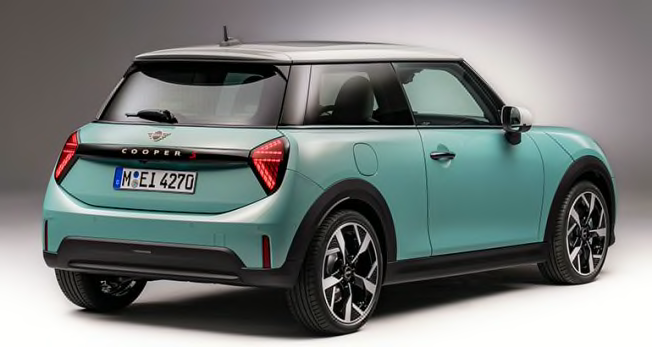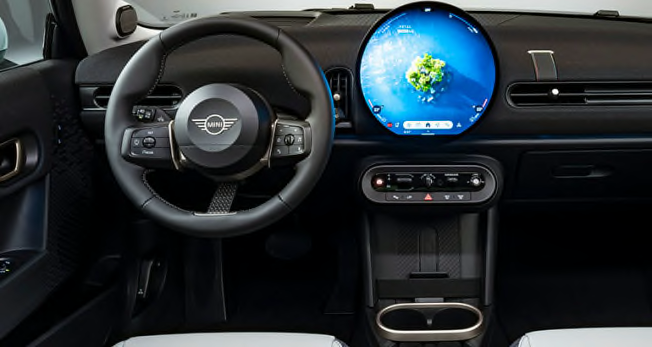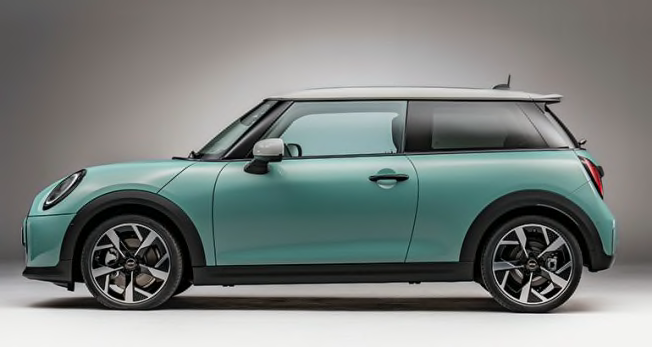Preview: Next-Generation 2025 Mini Cooper Gains Power, Tech
A familiar exterior houses a mini-malist interior

Mini continues its portfolio overhaul with the redesigned, fifth-generation Cooper. This model has been at the heart of the brand since it was founded 65 years ago. The concept remains the same for the 2025 Cooper three-door, with a familiar silhouette, a minimalist interior, and the promise of uncommon agility. Its overall dimensions remain unchanged.
- Mini Cooper: CR's Take Outside Inside What Drives It?
CR's Take
The Mini Cooper is among the most iconic models ever made, remaining true to its original design and concept for decades. Arguably, the Ford Mustang and Porsche 911 may be the only other cars that have had such longevity. (The Chevrolet Corvette gave up its position in this exclusive club with the latest generation changing to a rear-engine configuration.)
It is no surprise then that the new Cooper remains instantly familiar. The move from a three-cylinder to a four-cylinder for the base version sounds intriguing. Even though the outgoing Cooper was spunky, there is something unsatisfying about having such a tiny engine in a sporty car. The increased power in the Cooper S is welcomed, as more power always is, so long as it doesn’t bring a costly fuel economy penalty.
The minimalist Apple-like interior aesthetic may have a distinct appeal for some technophiles, but it may be seen as a negative for some buyers who favor a traditional cabin, with things like a speedometer right in front of the driver. The interior execution makes a compelling case to upgrade to the head-up display and use the “Hey Mini” voice controls more than you might in a car with a more conventional layout. (We could imagine going, “Hey Mini, how fast am I going? And now? How about now?”)
Mini reliability has been a roller coaster over the years. But recently, with the aging Cooper and Countryman models, Mini has been right at the top of our brand rankings for new car reliability. A complete redesign, with a new engine and infotainment system, brings fresh risks for the model. The Cooper’s last major redesign was the 2014 model year. Looking ahead to the next brand rankings, Mini has a challenge, because it is also launching a new Countryman SUV for 2025. We hope the company has learned from past experiences. The survey data collected from owners will tell the tale.
The automaker has withheld some details thus far, making it hard to get a full picture of how the new Cooper may improve over the 2024 iteration. We are interested to learn about the inevitable John Cooper Works high-performance version, and if the convertible will be coming to the States. We hope so, because there are precious few drop-tops on the market these days.
Outside
The evolutionary styling is immediately recognizable as a Mini Cooper, with its short overhangs, flat roof, forward-canted stance, and friendly face, with an octagonal, mouth-like grille and signature round headlights. The body itself looks more aerodynamic (ahem, melted), with its smooth surfaces, and the rear LED lights integrate a Union Jack design.
A panoramic glass top lets the light shine, no doubt helping the cabin feel a bit more airy.
There are many ways to personalize the appearance through body, roof, and interior trim color combinations. There is even a three-tone top available.
Wheels come in 17- and 18-inch sizes.

Photo: Mini Photo: Mini
Inside
The cabin’s simplicity is striking, with the 9.4-inch center screen being the dominant element (shown below). It is sized like a small pizza, and it has a distinctly monocular appearance that reminds of Mike Wazowski from the movie "Monsters, Inc."
There are conventional controls on the steering wheel and below the screen, but otherwise, the circular display handles most information and entertainment functions. Notably, speed and fuel consumption are shown at the top of the screen.

Photo: Mini Photo: Mini
An available navigation package adds a head-up display with augmented reality, which can overlay guidance on the road ahead, akin to what new BMWs offer.
Beneath the cyclopean display are a few small controls, with the most notable one being the gear selector. This is a wee toggle switch. Shifting to this design saves some packaging space, which has been used for a wireless phone charge mat. As before, it appears interior storage is limited—limited mostly to your pockets.
Fitting with its tech evolution, the Cooper can use a smartphone as a key. Approaching the car with the activated Mini app will trigger a welcoming animation and the doors unlocking from 10 feet away. This function can be granted to others via the app, making it easier to share the car in a pinch.

Photo: Mini Photo: Mini
What Drives It
The base Cooper will use a 2.0-liter turbocharged four-cylinder engine. For global markets, it is rated at 156 hp; Mini will release more details on this powertrain for the U.S. closer to its summer on-sale date.
But Mini has shared that the sportier Cooper S will use a 2.0-liter turbocharged four-cylinder engine that generates 201 hp and 221 lb.-ft. of torque. The automaker claims 0-60 mph sprints can tick by in 6.3 seconds—that is about a second quicker than the last Cooper S we tested, with 189 hp.
Both engines are matched to a seven-speed, dual-clutch automatic transmission. A manual transmission is not offered.
The base Cooper E is powered by a 135-kW/184-hp electric motor and uses a 40.7-kWh battery, while the more powerful Cooper SE has a 160-kW/218-hp motor and a larger 54.2-kWh battery. Both versions are front-wheel drive. At-home charging speed is 11 kW for both; at DC fast chargers the Cooper E can charge at speeds up to 75 kW, while the SE speed is up to 95 kW. This, Mini claims, allows the battery to be charged from 10 percent to 80 percent in less than 30 minutes.

Photo: Mini Photo: Mini


















